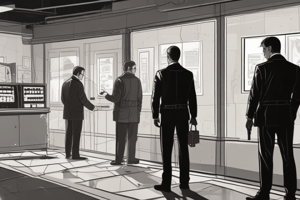Podcast
Questions and Answers
What is the primary role of forensic scientists compared to CSI technicians?
What is the primary role of forensic scientists compared to CSI technicians?
Forensic scientists analyze evidence in laboratories, while CSI technicians collect evidence in the field.
Define direct evidence and provide an example.
Define direct evidence and provide an example.
Direct evidence supports the truth of an assertion directly, such as eyewitness testimony.
Explain Locard’s Principle of Exchange.
Explain Locard’s Principle of Exchange.
Locard’s Principle states that the perpetrator of a crime will bring something into the crime scene and leave with something, which can be analyzed as evidence.
What are the key steps in processing a crime scene?
What are the key steps in processing a crime scene?
How should biological evidence be collected and preserved?
How should biological evidence be collected and preserved?
What distinguishes demonstrative evidence from real evidence?
What distinguishes demonstrative evidence from real evidence?
Why is the chain of custody important in evidence handling?
Why is the chain of custody important in evidence handling?
Can you give an example of circumstantial evidence?
Can you give an example of circumstantial evidence?
Flashcards
Forensic Science
Forensic Science
The application of science to criminal and civil laws, including toxicology, pathology, and DNA analysis.
Crime Scene Investigation (CSI)
Crime Scene Investigation (CSI)
The process of documenting, collecting, and preserving physical evidence from a crime scene.
Direct vs. Circumstantial Evidence
Direct vs. Circumstantial Evidence
Direct evidence directly proves a fact; circumstantial evidence implies a fact through inference.
Locard's Principle of Exchange
Locard's Principle of Exchange
Signup and view all the flashcards
Physical Evidence
Physical Evidence
Signup and view all the flashcards
Chain of Custody
Chain of Custody
Signup and view all the flashcards
Evidence Collection
Evidence Collection
Signup and view all the flashcards
Securing Evidence
Securing Evidence
Signup and view all the flashcards
Study Notes
Forensic Science vs. Crime Scene Investigation (CSI)
- Forensic science applies scientific methods to legal cases, encompassing fields like toxicology, pathology, and DNA analysis
- Crime scene investigation (CSI) documents, collects, and preserves evidence from a crime scene
- Forensic scientists work in labs, analyzing evidence, while CSI technicians work in the field collecting it
- Media often conflates these roles, but they are distinct professions
Categories of Evidence
-
Direct vs. Circumstantial Evidence: Direct evidence proves a point directly; circumstantial evidence suggests a point indirectly.
-
Burden of Proof: Legal standard for proving a charge
-
Classifying Evidence:
- Demonstrative evidence (e.g., diagrams), real evidence (physical objects), observational evidence (witness accounts)
- Accidental or class evidence (common to many), known or unknown evidence (origin traceable or not)
-
Physical Evidence:
- Finding physical evidence is crucial for understanding events and building a case.
- Locard's principle of exchange states that every contact leaves a trace
- Examples include fingerprints, fibers, weapons, etc.
Processing a Crime Scene
- Securing the Scene: Isolating the area to prevent contamination
- Scene Survey & Evidence Recognition: Identifying possible points of contact, and evidence
- Scene Searches: Systematic methods for locating evidence
- Documentation: Recording all steps in a detailed log, photographs, and sketches
- Evidence Collection & Preservation: Safe collection and preservation of all relevant items
- Release of the Scene: Releasing the area for its intended purpose once evidence has been collected
Collecting and Preserving Evidence
-
Securing Evidence: Protecting evidence from contamination or damage
-
Biological vs. Non-Biological Evidence: Differentiating between living matter and inanimate objects
-
Collecting Evidence: Using proper techniques, such as chain-of-custody, to avoid contamination
-
Packaging Evidence: Protecting it from damage and contamination, with specialized containers for different types of evidence
-
Sealing Evidence: Using secure seals to show a record of evidence handling
-
Labeling Evidence & Chain of Custody: Marking each piece distinctly and maintaining a complete record of its handling to maintain its integrity.
Studying That Suits You
Use AI to generate personalized quizzes and flashcards to suit your learning preferences.




